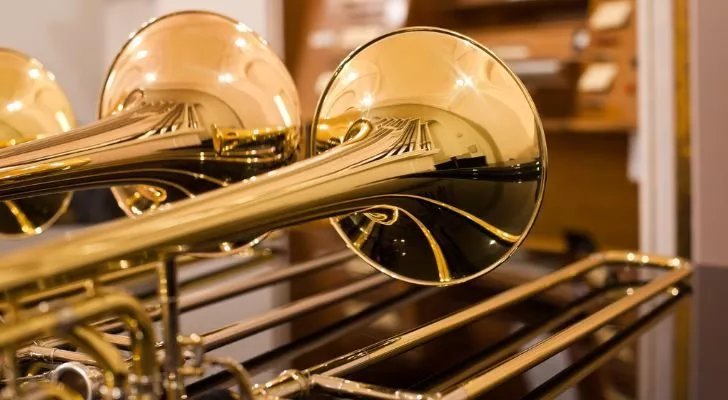The trombone was created in the 15th century.
First made in the 15th century, the trombone has certainly made its mark in music history. Although, the original design, essentially a modified trumpet, is not the same as what we have today.
At that time, it had another name, the sackbut. Unlike the modern trombone, the sackbut had a narrower bore and a much smaller flare.
It also lacks a water key, bell curve tuning slide, and slide lock.
Although both musical instruments are similar, you can’t play the traditional sackbut repertoire on the modern trombone.
The first time a trombone was played publicly was at a wedding.
During the banquet, they had the musicians dress up as animals. The trombone player dressed up as a he-goat!
Beethoven changed the fate of the trombone.
Composers of that era saw the trombone as a sacred instrument and treated it as such. That’s until Beethoven changed the narrative.
He included the trombone in a secular symphony, Symphony No. 5 in C minor, Op. 67 (Fate), for the first time in 1808.
Therefore, the trombone took center stage in the 19th century thanks to his influence.
The trombone is sometimes called “the voice of God.”
Carlos Chavez, a 20th-century South American composer, said the trombone exerted significant influence over the entire orchestra.
The trombone can sing like a human.
The trombone has an incredible range similar to the human voice.
Even now, modern composers highlight this similarity to the human voice. To achieve this effect, they may use a plunger mite in Jazz.
Want to hear it yourself? Check out the Peanuts cartoon series. The “Wah-Wah” sounds from adults, such as Charlie’s parents and teachers, in the series were made using a trombone.
The trombone isn’t left-hand friendly.
Some left-handed trombone players may place it over their right shoulder to move the slide with their left hand.
It may look a little awkward if you’ve never seen it done before. Ever seen someone play the trombone left-handed?
Jazz trombonist Locksley Wellington (Slide) Hampton did. He was right-handed but played with his left hand because his first trombone was configured for left-handed play.
Its name is derived from Italian.

The suffix “-one” means large. Therefore the word trombone directly translates to large trumpet.
It’s the only brass instrument with a slide.
Brass instruments, such as the tuba, French horn, and cornet, have one thing in common – valves.
You press them down for a new pitch on the instrument. Not the trombone, however.
Instead of valves, it has a seven-position slide. Sliding from one position to the next changes its pitch.
The Schnitzer family was one of the most respected makers of musical instruments of the 16th century.
Its family members were musicians and made several instruments, such as trumpets and trombones.
Trombones can be pricey.
On the other hand, high-end musical instruments may cost you a pretty penny, and you could easily pay over $10,000 for one.
Well, some may say it’s the price you pay if you’re after outstanding craftsmanship!
The trombone’s known for its unique way of standing out in a band. It adds that flair to any song that it’s a part of.
It’s a versatile musical instrument that fits anywhere, including bands and orchestras.
The brass instrument, often regarded as the backbone of the marching band, deserves all the love it gets.



 Users Today : 25
Users Today : 25 Total views : 665037
Total views : 665037